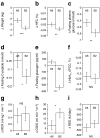Eating two larger meals a day (breakfast and lunch) is more effective than six smaller meals in a reduced-energy regimen for patients with type 2 diabetes: a randomised crossover study
- PMID: 24838678
- PMCID: PMC4079942
- DOI: 10.1007/s00125-014-3253-5
Eating two larger meals a day (breakfast and lunch) is more effective than six smaller meals in a reduced-energy regimen for patients with type 2 diabetes: a randomised crossover study
Erratum in
-
Erratum to: Eating two larger meals a day (breakfast and lunch) is more effective than six smaller meals in a reduced-energy regimen for patients with type 2 diabetes: a randomised crossover study.Diabetologia. 2015 Jan;58(1):205. doi: 10.1007/s00125-014-3411-9. Diabetologia. 2015. PMID: 25316434 Free PMC article. No abstract available.
Abstract
Aims/hypothesis: The aim of the study was to compare the effect of six (A6 regimen) vs two meals a day, breakfast and lunch (B2 regimen), on body weight, hepatic fat content (HFC), insulin resistance and beta cell function.
Methods: In a randomised, open, crossover, single-centre study (conducted in Prague, Czech Republic), we assigned 54 patients with type 2 diabetes treated with oral hypoglycaemic agents, both men and women, age 30-70 years, BMI 27-50 kg/m(2) and HbA1c 6-11.8% (42-105 mmol/mol), to follow two regimens of a hypoenergetic diet, A6 and B2, each for 12 weeks. Randomisation and allocation to trial groups (n = 27 and n = 27) were carried out by a central computer system. Individual calculations of energy requirements for both regimens were based on the formula: (resting energy expenditure × 1.5) - 2,092 kJ. The diet in both regimens had the same macronutrient and energy content. HFC was measured by proton magnetic resonance spectroscopy. Insulin sensitivity was measured by isoglycaemic-hyperinsulinaemic clamp and calculated by mathematical modelling as oral glucose insulin sensitivity (OGIS). Beta cell function was assessed during standard meal tests by C-peptide deconvolution and was quantified with a mathematical model. For statistical analysis, 2 × 2 crossover ANOVA was used.
Results: The intention-to-treat analysis included all participants (n = 54). Body weight decreased in both regimens (p < 0.001), more for B2 (-2.3 kg; 95% CI -2.7, -2.0 kg for A6 vs -3.7 kg; 95% CI -4.1, -3.4 kg for B2; p < 0.001). HFC decreased in response to both regimens (p < 0.001), more for B2 (-0.03%; 95% CI -0.033%, -0.027% for A6 vs -0.04%; 95% CI -0.041%, -0.035% for B2; p = 0.009). Fasting plasma glucose and C-peptide levels decreased in both regimens (p < 0.001), more for B2 (p = 0.004 and p = 0.04, respectively). Fasting plasma glucagon decreased with the B2 regimen (p < 0.001), whereas it increased (p = 0.04) for the A6 regimen (p < 0.001). OGIS increased in both regimens (p < 0.01), more for B2 (p = 0.01). No adverse events were observed for either regimen.
Conclusions/interpretation: Eating only breakfast and lunch reduced body weight, HFC, fasting plasma glucose, C-peptide and glucagon, and increased OGIS, more than the same caloric restriction split into six meals. These results suggest that, for type 2 diabetic patients on a hypoenergetic diet, eating larger breakfasts and lunches may be more beneficial than six smaller meals during the day. Trial registration ClinicalTrials.gov number, NCT01277471, completed. Funding Grant NT/11238-4 from Ministry of Health, Prague, Czech Republic and the Agency of Charles University - GAUK No 702312.
Figures


References
Publication types
MeSH terms
Substances
Associated data
LinkOut - more resources
Full Text Sources
Other Literature Sources
Medical
Research Materials

